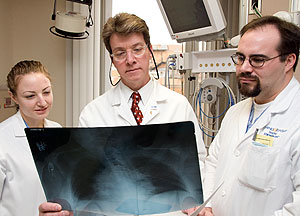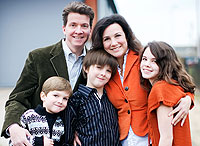In France, J. Perren Cobb, M.D., would be called a “reanimateur” — a critical-care doctor who specializes in bringing patients back from the brink of death. Here in the States, however, he is an intensivist, a rather bland term that reveals little about the awe-inspiring nature of his work.
“Reanimateur better defines what we do,” Cobb says. “In the intensive care unit, we are reanimating those who would otherwise be dead. I like the word because it stresses that what we’re doing is positive and focused on healing — the glass is half-full as opposed to half-empty approach.”

Cobb, professor of surgery and of anesthesiology, cares for patients in the surgical intensive care unit (SICU) on the eighth floor of Barnes-Jewish Hospital. Patients typically arrive on ventilators after major surgery, such as complicated operations to repair a ruptured blood vessel or close a gaping wound from a car crash or other traumatic incident.
The vast majority of patients recover fully. But a significant number, especially those with severe injuries caused by burns or major trauma, face long and difficult recoveries plagued by potentially fatal complications. For these patients, an SICU stay is a touch-and-go struggle for life as Cobb and others deal with one medical crisis after another to stabilize their conditions.
“People with traumatic injuries that at one time would have been fatal can be put on ventilators and kept alive in states that never existed before,” Cobb says. “But our ability to treat these patients still mostly amounts to a holding measure — the ventilator buys us time to try to resolve their underlying medical issues.”
Sometimes, despite all heroic measures, critically ill patients’ progress suddenly stalls and their organs begin to fail as doctors stand by helplessly.
“The technology exists to fix a hole in the blood vessel, to sew up the intestine or to cover burns with skin grafts,” Cobb says. “But there’s a tight window of time for patients in shock to get aggressive treatment. When patients cross that threshold, their organs start to fail, and there’s absolutely nothing we can do but stand there and watch them die. That is what keeps me up at night and motivates me to find answers.”
Physicians currently have no way to predict which critically ill or injured patients will fall into this downward spiral and do not have treatments to prevent it. Frustrated by this, Cobb stopped performing surgery several years ago to instead focus on finding ways to improve patients’ odds for survival.
Looking to genes
Cobb’s search for answers explaining why one critically ill patient dies while another with the same injury lives has led him to the roots of illness: genes. While genes are known to play a role in diseases such as cancer, diabetes and heart disease, research by Cobb and his colleagues shows that a constellation of genes goes awry as the body responds to traumatic injury.

In recent years, Cobb has been a leader in evaluating whether gene chips, which can rapidly track patterns of activity of thousands of genes, can help explain on a molecular level how patients respond to critical illness and injury.
This line of investigation may eventually help to identify molecular markers to pinpoint the earliest onset of organ failure or infection, for example, giving doctors an opportunity to intervene before underlying conditions get out of hand.
Cobb has teamed with scientists throughout the country to use gene chips to detect changes in gene expression triggered by trauma. And in his own lab, he is using the chips to detect pneumonia associated with ventilator use and to distinguish sepsis, a fast-moving blood infection that is the leading cause of organ failure, from inflammation related to injury. Both pneumonia and sepsis are major problems in the ICU.
To develop the gene chip technology and evaluate its use in patients, Cobb has brought together scientists from diverse fields — genomics, surgery, anesthesiology, engineering, bioinformatics, mathematics and immunology.
“That takes a special talent, not only to bring different people together, but to get buy-in for how to move forward,” says Timothy Eberlein, M.D., the Bixby Professor and chairman of the Department of Surgery. “Perren Cobb is a world-class researcher and the nicest guy in the world. He has a vision for what it takes to solve complex medical problems in the real world. My only regret is that I can’t clone him.”
On a national level, Cobb recently led the inaugural meeting of the U.S. Critical Illness and Injury Trials Group. The gathering brought together for the first-time critical-care physicians, nurses and researchers to establish a cooperative research framework and clinical protocols that evaluate different approaches to caring for critically ill patients.
Making a difference
|
J. Perren Cobb |
|
Hometown: Louisville, Ky. Education: B.A., Vanderbilt University; M.D., University of Louisville School of Medicine Titles: Professor of surgery and of anesthesiology and associate professor of genetics. Cobb also founded and now directs the Center for Critical Illness and Health Engineering, which improves outcomes for the critically ill and injured through innovative biomedical research and hospital performance improvement. Family: Wife, Cindy; daughter, Shelby, 13; and sons Everett, 11, and Marshall, 5 Hobbies: Attending children’s school activities and sporting events and reading The Economist, The New York Times and the St. Louis Post-Dispatch |
Cobb was drawn to the field of surgery by his role model and mentor Hiram C. Polk Jr., M.D., former chairman of the Department of Surgery at the University of Louisville School of Medicine, where Cobb earned a medical degree. Polk was a general surgeon who had special expertise in trauma surgery.
“I came under his spell as a second-year medical student, and I wanted to be just like him,” Cobbs says. “He was a champion for every patient, and when I made rounds with him, I found the care of the critically ill and injured to be a very seductive field because it was so exciting.”
Cobb completed a general surgery residency at the University of California, San Francisco, followed by two critical-care fellowships, one at the National Institutes of Health and the other at the University of Pittsburgh.
He came to Washington University in 1995, intending to spend his career in the operating room as a trauma surgeon.
“But over time, it became very clear to me that I was increasingly attracted to what was going on in the ICU and the many questions we needed to answer to improve patient outcomes,” Cobb says.
In 2001, Cobb joined other researchers throughout the country as part of a massive study of trauma, funded by the National Institute of General Medical Sciences under a so-called “glue grant” mechanism. The 10-year project is teasing apart the complex set of events involved in the body’s reaction to traumatic injury.
That collaboration also was a springboard to others to advance the use of genomics to help track the course of critical illness.
“Perren is able to find the people who are involved in state-of-the-art research, who work with cutting-edge technologies and in fields not connected to medicine but that have a lot to offer to medicine,” says collaborator Jeanine P. Wiener-Kronish, M.D., anesthetist-in-chief at Massachusetts General Hospital. “He brings these people together so that ideas are shared and important work can be accomplished.”
In the SICU, Cobb is highly regarded as a passionate advocate for his patients and a calm presence in a high-stress environment.
“Dr. Cobb has a superb bedside manner and brings out the best in everyone involved in the care of patients he is overseeing,” says Walter A. Boyle III, M.D., professor of anesthesiology and of surgery and director of the Anesthesiology Critical Care Division. “Perren’s ability to put staff at ease and listen to their views optimizes the chances for good outcomes for patients.”
Although 5 million people are admitted to ICUs each year, and their care accounts for 15 percent to 20 percent of inpatient hospital costs, there are no national advocacy groups focused on ICU care as there are for cancer, heart disease and other specific conditions. Likewise, no federal agency is designated to fund critical care research. In raising awareness of the need for more attention to his field, Cobb finds the French term for his specialty particularly useful.
“We are challenged by the fact that the community we serve, patients and the public, has no idea what an intensivist is,” he says. “But a reanimateur — now that gets people’s attention. They don’t walk away from that conversation.”